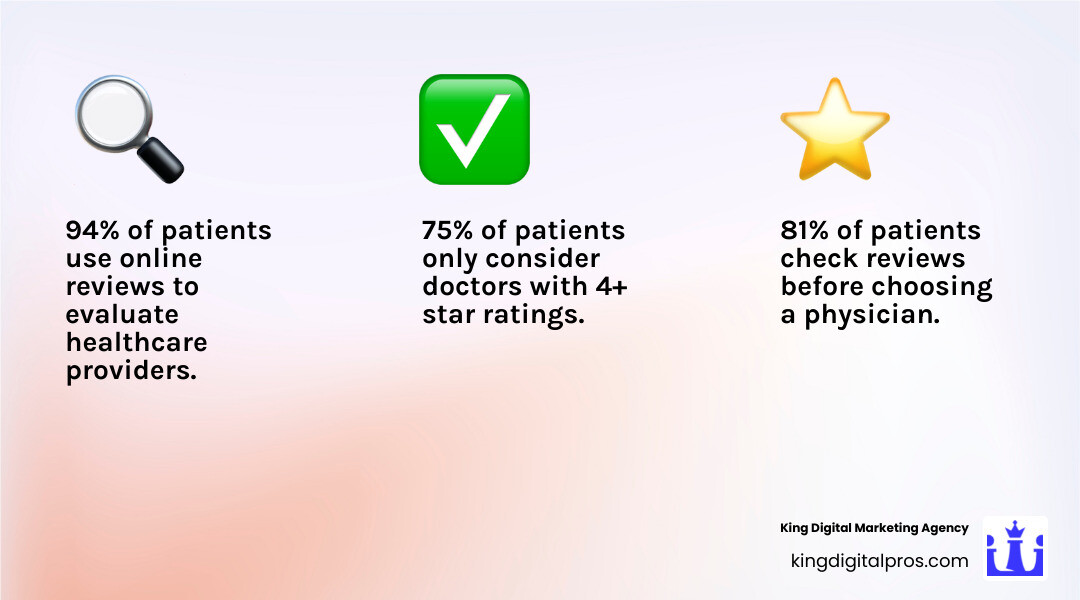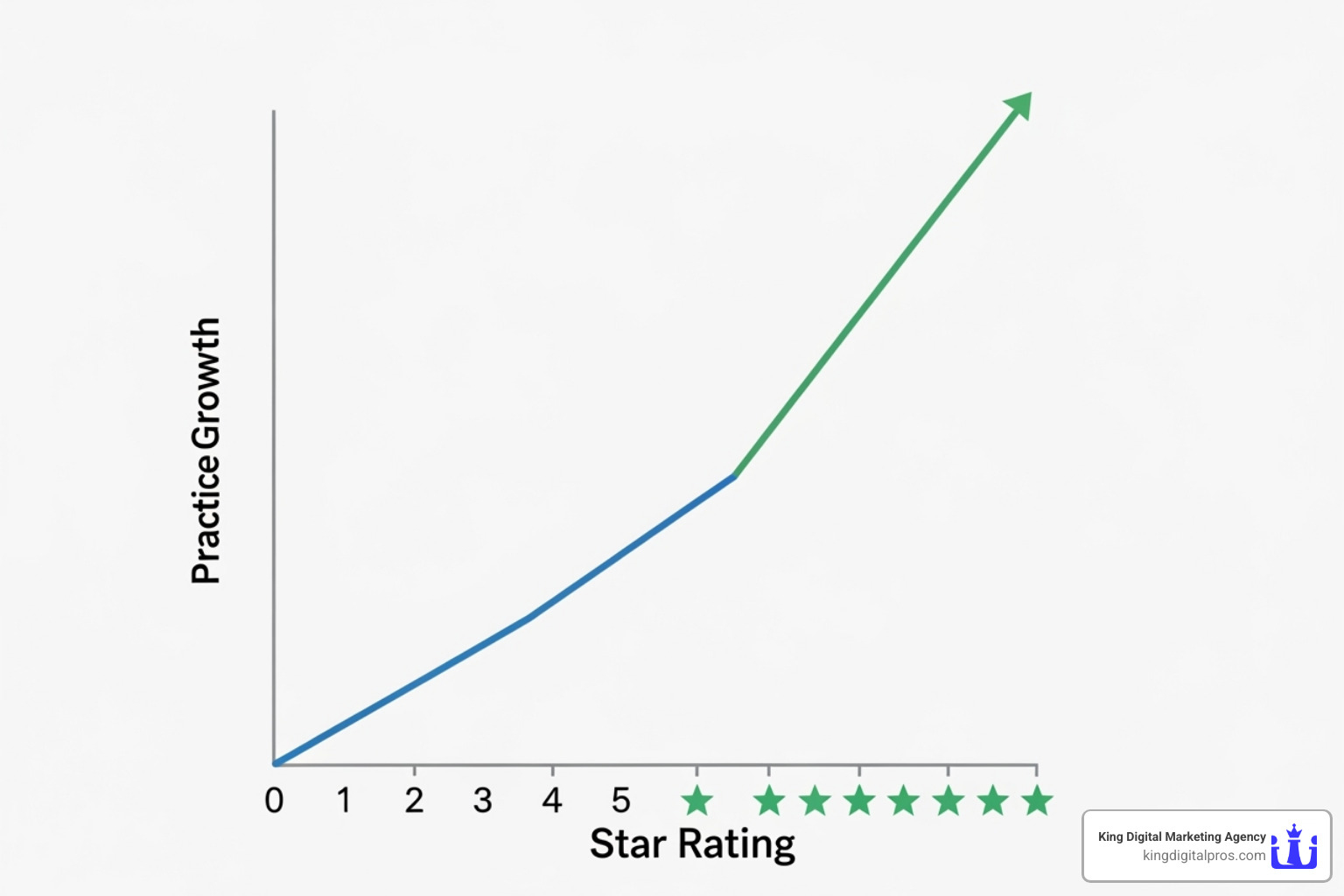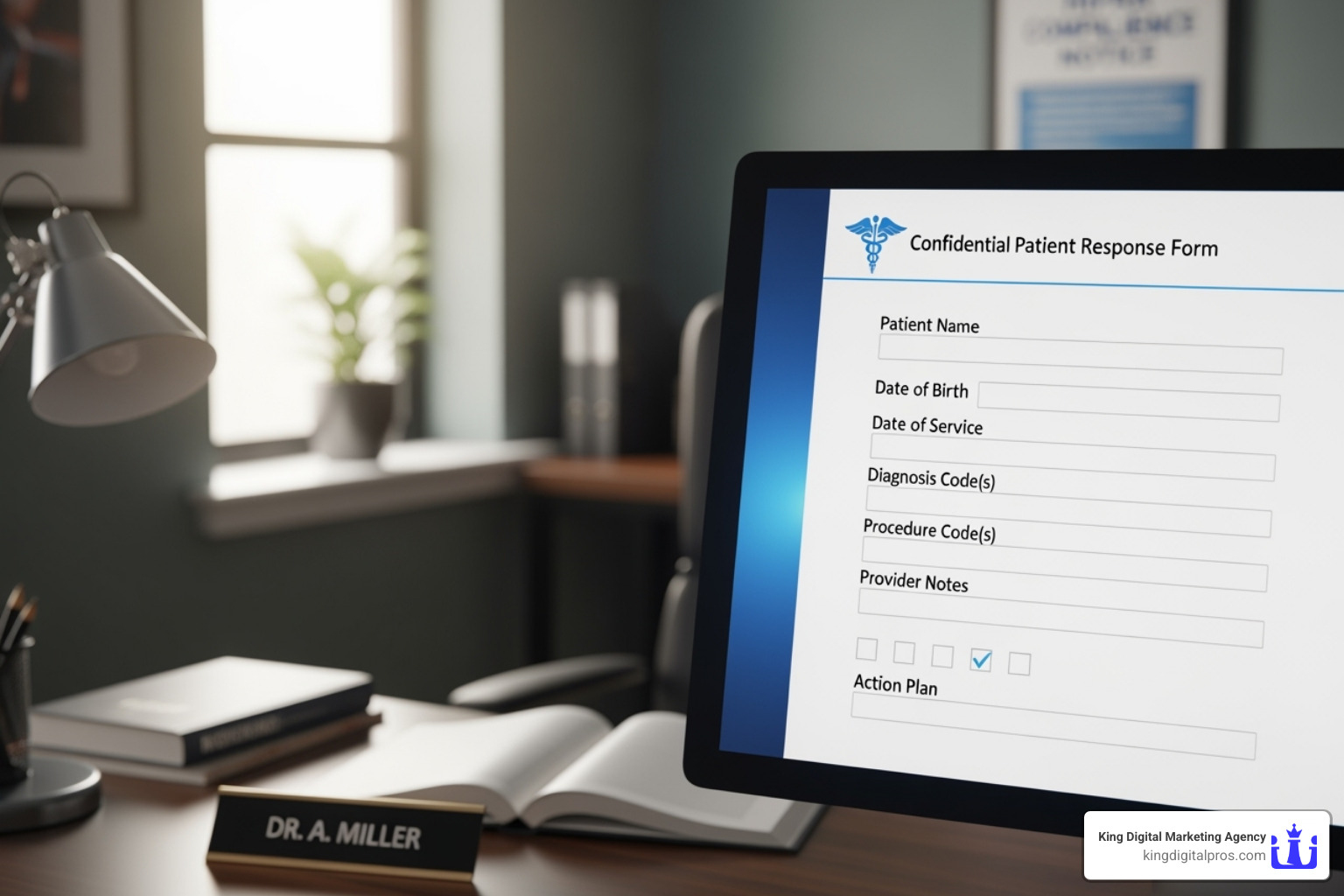Why Physician Review Management is Critical for Modern Medical Practices
Physician review management is the process of monitoring, influencing, and responding to patient reviews online to build trust and attract new patients.
Key Components of Effective Physician Review Management:
- Monitor reviews across platforms like Google, Healthgrades, and Vitals.
- Respond professionally to all reviews while maintaining HIPAA compliance.
- Generate positive reviews through strategic patient outreach.
- Optimize online profiles to maximize visibility.
- Improve the patient experience based on feedback.
- Protect your practice’s reputation from negative or fake reviews.
The numbers are compelling: 94% of patients use online reviews to evaluate healthcare providers, and 75% will only consider doctors with 4-star ratings or higher. With 81% of patients checking reviews before choosing a physician, your online reputation is essential for growth.
While excellent patient care is the foundation, today’s patients validate their healthcare decisions online before ever walking through your door. Patients spend 31% more on doctors with excellent reviews, while practices with poor online reputations lose patients daily. Your digital first impression often determines whether someone books an appointment.
I’m Bernadette King, founder of King Digital Marketing Agency. I’ve helped dozens of medical practices transform their online presence. My experience shows that proactive reputation management isn’t just damage control – it’s about systematically building the trust that drives practice growth.

Why Your Online Reputation Matters in Modern Healthcare
Your practice’s online reputation is its digital front door, working 24/7 to either attract new patients or send them to competitors. When someone needs a new doctor, they search online and read reviews. For 90% of patients, online reviews are a key part of deciding if you’re the right fit.
The financial impact is significant. Research from Harvard Business School shows that a one-star increase in your online rating can boost revenue by 5% to 9%. For healthcare, this translates to substantial growth. Since physician review management directly influences patient acquisition and retention, its effect on your bottom line is clear.

The Direct Impact of Reviews on Patient Decisions
Even patients who get a referral from a friend will check your reviews online – about 60% validate recommendations by reading what others say. Your online reviews have become the “second opinion” that seals the deal.
Positive reviews are seen as proof of quality care, and 64% of patients are willing to pay more for doctors with higher ratings. They are happy to invest in what they perceive as better service. This means your online reputation doesn’t just attract patients; it positions you as a premium provider.
Patients trust online feedback nearly as much as personal recommendations. When they see consistent positive reviews mentioning your bedside manner, expertise, and efficient office, it builds confidence before they even contact you. Your reviews become powerful testimonials working around the clock.
The Financial and Reputational Risks of a Poor Online Presence
Ignoring your online reputation can seriously damage your practice. When 84% of patients rely on online reviews, poor ratings don’t just hurt feelings – they hurt revenue.
The most immediate impact is lost patients. Every low rating can send potential patients to competitors. They aren’t calling for your side of the story; they’re simply moving on to the next doctor with better reviews. This steady loss of new patients creates a significant revenue drain.
Beyond the financial hit, a damaged online reputation erodes trust. It affects how current patients perceive you, making them more likely to switch providers. It also makes it harder to attract top talent, as skilled medical professionals research potential employers online. In competitive healthcare markets, your online reputation often becomes the deciding factor for patients and staff alike. Neglecting physician review management hands your potential patients over to competitors who have built strong digital credibility.
Core Strategies for Effective Physician Review Management
Effective physician review management bridges the gap between the excellent care you provide and the patients searching for you. It’s about creating systems that showcase your practice’s strengths while continuously improving the patient experience. A proactive approach involves the entire team, from front desk staff to the billing department, in creating positive interactions that lead to great reviews.
This strategy starts with establishing your digital presence, generating authentic feedback, and ensuring every patient interaction is five-star worthy. For a deeper dive, our Medical Practice Reputation Management Guide walks you through each step.
Building and Optimizing Your Essential Online Presence
Patients must be able to find you online. Surprisingly, many physicians are nearly invisible in digital searches. Only 19% of doctors have an active Google profile, yet 59% of patients read Google My Business reviews before booking.
- Google Business Profile: This is your digital front door. It’s free and is often a patient’s first impression. Fill out every section: services, contact info, hours, website, and professional photos. Regular posts keep your profile active.
- Practice Website: Your website is your digital headquarters. It should be clean, professional, mobile-friendly, and detail your services and background.
- Healthcare-Specific Review Sites: Platforms like Healthgrades, Vitals, and Zocdoc are crucial, as patients actively compare physicians there. Claim your profiles, ensure all information is accurate, and monitor them regularly.
- Social Media Profiles: While not primarily for reviews, platforms like Facebook help patients get a sense of your practice’s personality, making you seem more approachable.
Our expertise in attracting customers via Google Maps has helped practices in areas like Albuquerque and Santa Fe dramatically increase their local visibility.
Best Practices for Generating a Steady Stream of Positive Reviews
Getting positive reviews requires a systematic, simple process. Most satisfied patients are willing to help, but they need a gentle nudge and an easy way to share their experience.
Train your staff to recognize satisfied patients. When a patient expresses gratitude, that’s the cue. A simple request like, “We’re so glad you had a positive experience! Would you mind sharing your feedback online? It helps other patients find us,” works well.
Automated follow-up messages via email or text after appointments are highly effective, as the experience is still fresh. These should express gratitude and provide direct links to your review profiles. Studies show 70% of reviews come from these post-appointment requests.
In-office visual reminders, like a “Review Us on Google” card or a QR code poster, also work well. The key is to be helpful, not demanding.

Timing is critical. The ideal window is 24-48 hours after an appointment. Most importantly, make the process effortless with clear instructions and direct links. Every extra click reduces the chance a patient will follow through.
Improving the Patient Experience to Earn Better Reviews
Digital strategies can’t fix a poor patient experience. The best reviews come from patients who feel cared for and respected.
- Streamline Appointments: Long waits and confusing check-ins are major frustrations. Use digital check-in systems and realistic scheduling to show respect for patients’ time.
- Improve Staff Communication: Train your team in empathetic listening and clear communication. A comforting approach makes a huge difference, especially for anxious patients.
- Ensure Billing Transparency: Surprise bills cause frustration. Explain costs upfront and handle billing questions with patience to prevent negative reviews.
- Conduct Post-Visit Follow-Up: A brief call to check on a patient shows you care about their well-being beyond the appointment.
- Improve the Physical Environment: A clean, comfortable waiting room with clear signage sets a positive tone from the start.
According to The Beryl Institute, 91% of consumers say the patient experience is significant to their healthcare decisions. When you create consistently positive experiences, five-star reviews will follow, supporting patient retention and practice growth.
The Art of Responding to Patient Reviews (HIPAA-Compliant)
Responding to patient reviews requires balancing engagement with patient privacy, a common concern for physicians. In a recent survey, 37% identified confidentiality as their biggest worry. However, with the right approach, you can respond professionally and de-escalate tension while remaining fully HIPAA-compliant. Each response is an opportunity to demonstrate your practice’s values to the public.

Responding to Positive Reviews
Positive reviews deserve as much attention as negative ones. Thanking patients for kind words reinforces positive behavior and shows prospective patients you care about their experience.
Start with genuine gratitude, like “Thank you for sharing your experience.” Then, reinforce the positive points they mentioned. If they praised a staff member, acknowledge it: “We’re so glad Sarah made you feel comfortable.” This makes the response feel personalized. Avoid using the same generic reply for every review.
Conclude by encouraging future engagement, such as “We look forward to continuing to provide you with excellent care.” This reinforces the patient relationship.
Navigating Negative Reviews While Upholding HIPAA
While negative reviews sting, responding is a powerful opportunity: 45% of consumers are more likely to visit a business that responds to negative reviews. A thoughtful response can even change a customer’s opinion.
The secret is in your approach:
- Acknowledge the feedback. Start with “Thank you for sharing your experience” to show you’re listening.
- Apologize for their experience. Say, “We’re truly sorry to hear that your experience didn’t meet your expectations.” This shows empathy without admitting fault or confirming details.
- Take the conversation offline. This is the most critical step for HIPAA compliance. Say, “We take all feedback seriously. Please contact our office manager at [phone number] to discuss your concerns directly.” This protects patient privacy and shows you want to resolve the issue.
The golden rule of negative review responses is to never confirm someone is your patient or share any Protected Health Information. Your response must be general. For current guidance, always refer to official HIPAA guidelines.
Finally, never argue publicly. It looks unprofessional and can lead to HIPAA violations. Keep your tone calm and focused on resolution. Everyone reading the exchange, including potential patients, is watching how you handle criticism.
Proactive Monitoring and Leveraging Feedback
Think of physician review management as your practice’s early warning system. Successful practices don’t just wait for reviews; they actively monitor their digital footprint and use feedback as fuel for improvement. This proactive approach separates thriving practices from those struggling with their online reputation.
At King Digital, we’ve seen how continuous monitoring transforms a practice’s trajectory, whether in Grants NM or Cedar Crest NM. This approach protects your reputation while improving patient care. For support, our Google Business Listing Help is a great starting point.
Tools and Techniques for Monitoring Your Reputation
Staying informed allows you to respond quickly and appropriately. We recommend a multi-layered approach:
- Google Alerts: Set up free alerts for your practice and physician names to get immediate email notifications of new online content.
- Review Management Platforms: These tools centralize all your reviews into one dashboard, saving time and often including sentiment analysis to spot trends.
- Social Media Monitoring: Patients often share experiences on Facebook or in local groups. Monitoring these platforms is crucial for comprehensive reputation management.
- Proactive Manual Searches: Regularly searching for your practice can catch mentions that automated tools might miss.
Consistency is key. Daily or frequent monitoring allows for timely responses that can prevent small issues from escalating.
Turning Patient Feedback into Actionable Practice Improvements
The true power of review management lies in turning feedback into actionable improvements. Every review contains valuable intelligence.
- Analyze Review Sentiment: Look for patterns. Are multiple people mentioning long wait times or confusing billing? These trends tell a story that individual reviews might miss.
- Share Feedback with Your Team: Discuss reviews in staff meetings, not to assign blame, but to identify opportunities for improvement together.
- Implement Targeted Changes: If reviews mention parking issues, consider reserved patient spaces. If billing is a problem, revamp your explanation process. The Centers for Medicare & Medicaid Services notes that patient experience improvements correlate with better outcomes.
- Communicate Improvements: When you respond to new reviews, mention how you’ve addressed past concerns. This shows that you listen and are committed to continuous improvement.
This approach transforms your practice into a learning organization where patient feedback drives real change. You’ll start seeing reviews as free consulting advice from your patients.
Frequently Asked Questions about Physician Review Management
Managing your online reputation can feel overwhelming. Here are the most common questions we hear from physicians ready to take control of their digital presence.
How do I start managing my practice’s online reputation?
Start with a self-audit. Google your practice and physicians to see what patients find on sites like Google, Healthgrades, or Vitals. This will reveal any gaps, like outdated information or unmonitored review platforms.
Next, claim and optimize your key online profiles. Begin with your Google Business Profile, as it’s often the first thing patients see in areas like Edgewood NM or Sandia Park NM. Fill out every section completely – services, hours, photos, and contact information – to appear more trustworthy to patients and search engines.
Is it a HIPAA violation to respond to patient reviews?
No, responding to patient reviews is not a HIPAA violation if done correctly. The golden rule is to never acknowledge that the reviewer is a patient or disclose any Protected Health Information (PHI). Keep your responses general.
For example, instead of discussing their medical care, say, “We’re sorry to hear your experience didn’t meet expectations.” Then, offer to take the conversation offline: “Please contact our office manager at [phone number] so we can address your concerns privately.”
How can I handle fake or malicious negative reviews?
Handle fake reviews professionally, not emotionally. First, post one calm, professional response. If you have no record of the person, you can state: “We take all feedback seriously but cannot locate a record of your visit. Please contact our office directly so we can address your concerns.”
Next, flag the review for removal through the platform’s reporting system. Most sites have strict policies against fake content. Provide any evidence that it violates their terms of service, such as having no patient record. Never engage in a public argument; your professional response is enough to show other readers you handle conflict maturely.
Conclusion: Take Control of Your Digital Credibility
Your online reputation is the gateway to patient trust, and physician review management is the key. In our digital-first world, patients form opinions about your practice long before they step into your office. Their first Google search and the reviews they read often determine whether they choose you or a competitor.
The strategies we’ve covered – from optimizing your Google Business Profile to crafting HIPAA-compliant responses – create a comprehensive approach to your online reputation. When you proactively generate positive reviews, respond professionally to all feedback, and use patient insights to improve, you are actively building the trust that drives practice growth.
The long-term benefits extend beyond attracting new patients. A strong online presence helps retain existing patients, recruit top talent, and establish your practice as a trusted community leader. Your digital credibility is the foundation for sustainable growth.
At King Digital Marketing Agency, we’ve seen how the right approach to physician review management can transform a medical practice. We understand that your time is best spent caring for patients, not wrestling with review platforms. Our expertise in optimizing Google Business Profiles helps healthcare providers take control of their digital narrative.
Taking action today protects your practice’s future. Don’t let potential patients make decisions based on incomplete or outdated information. The digital landscape rewards those who engage proactively.
Ready to transform how patients find and choose your practice? Our comprehensive Reputation Management Services are designed for healthcare providers who want to build lasting digital credibility while focusing on what they do best: providing exceptional patient care.


